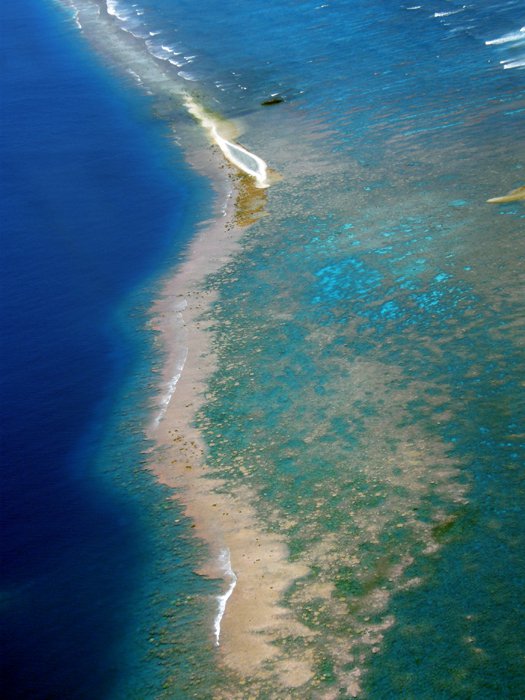Kingman Reef is a largely submerged, uninhabited triangular shaped reef, 9.5 nautical miles east-west and 5 nautical miles north-south, located in the North Pacific Ocean, roughly half way between the Hawaiian Islands and American Samoa at 6°23′N 162°25′W. It is 930 nautical miles south of Honolulu.
The reef encloses a lagoon up to 270 feet deep in its western part. The total area within the outer rim of the reef is 29 sq mi. There are two small strips of dry land composed of coral rubble and giant clamshells on the eastern rim with areas of 2 acres and 1 acre having a coastline of 2 mi. The highest point on the reef is less than 5 feet above sea level, which is wetted or awash most of the time, making Kingman Reef a maritime hazard. It has no natural resources and supports no economic activity.
The atoll is closed to the public.
The pre-20th century names Danger Reef, Caldew Reef, Maria Shoal and Crane Shoal refer to this atoll, which by then was entirely submerged at high tide.
Kingman Reef was discovered by the American Captain Edmund Fanning of the ship Betsey on June 14, 1798. Captain W. E. Kingman (whose name the island bears) described it on November 29, 1853. It was claimed for the United States under the name “Danger Reef” by the Guano Islands Act of 1856.
The lagoon was used in 1937 and 1938 as a halfway station between Hawai’i and American Samoa by Pan American Airways flying boats (Sikorsky S-42B). Pan Am decided that the lagoon at Kingman Reef was suitable for overnight stops en route from the U.S to New Zealand via Samoa. Kingman Reef became the stopover to and from Pago Pago, American Samoa, located 1,600 miles further south. A supply ship, the North Wind, was stationed at Kingman Reef to provide fuel, lodging, and meals. The flight on January 11, 1938 ended in tragedy. Shortly after the early morning take off from Pago Pago, bound for New Zealand the plane burst into flames while dumping fuel, and there were no survivors. As a result of the tragedy, Pan Am ended flights to New Zealand via Kingman Reef and Pago Pago.
On December 29, 1934 the US Navy assumed jurisdiction over Kingman Reef. On September 1, 2000 the Navy relinquished its control over Kingman Reef to the US Department of the Interior and on January 18, 2001 the Secretary of the Interior signed Secretary’s Order 3223 establishing Kingman Reef as a National Wildlife Refuge including 484,000 acres. In January 2009, Kingman Reef was designated a marine national monument.
Ecology
Kingman Reef supports a vast variety of marine life. Giant clams are abundant in the shallows, and there are approximately 38 genera and 130 species of stony corals present on the reef. This is more than three times the species diversity of corals found in the main Hawaiian Islands. The ecosystem of the reef and its subsequent food chain are known for the distinct quality of being primarily predator-based. The percentage of the total fish biomass on the reef is made up of 85% apex predators, creating a high level of competition for food and nutrients among local organisms — particularly sharks, jacks and other carnivores. The threatened green sea turtles that frequent nearby Palmyra atoll travel to Kingman Reef to forage and bask on the coral rubble spits at low tide.
Above sea level the reef is usually barren of macroorganisms, however. Mainly constructed of dead and dried coral skeletons, providing only calcite as a source of nutrients, the small and narrow strips of dry land are only habitable by a handful of species for short periods of time. Most flora which begin to grow above water — primarily coconut palms — die out quickly due to the fierce tides and lack of resources necessary to sustain plant life.
From Wikipedia
